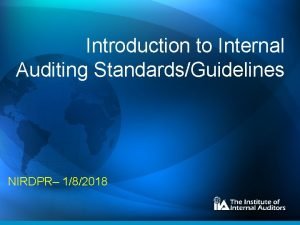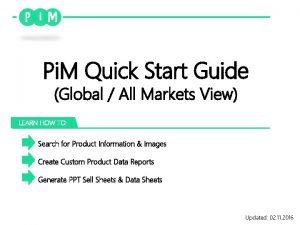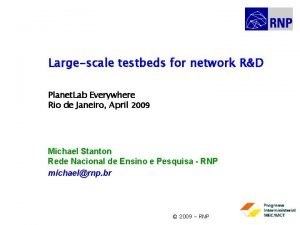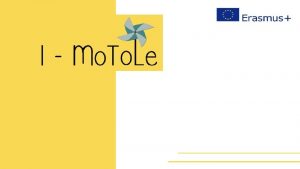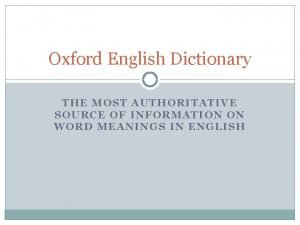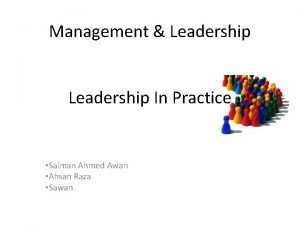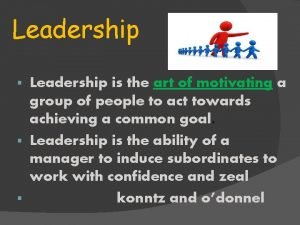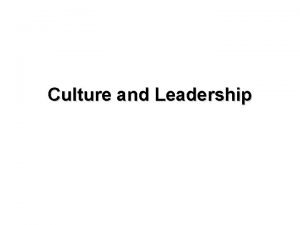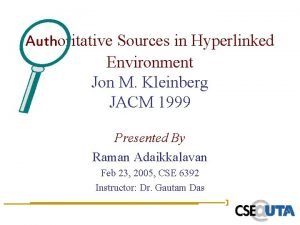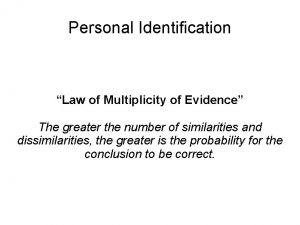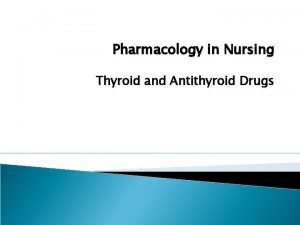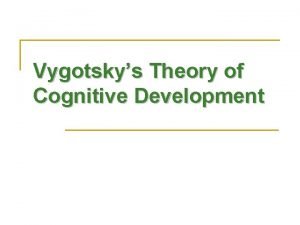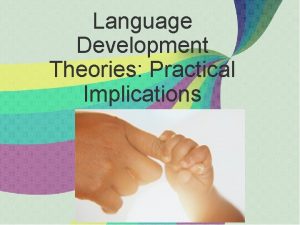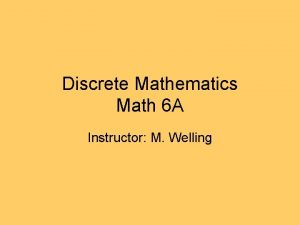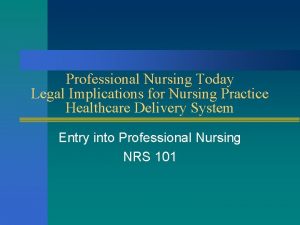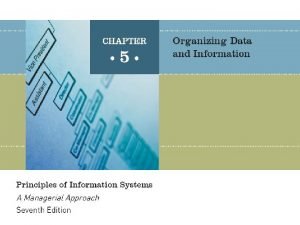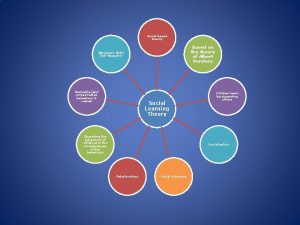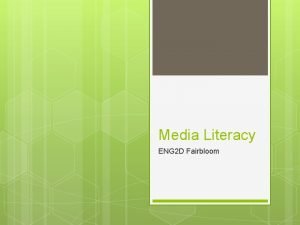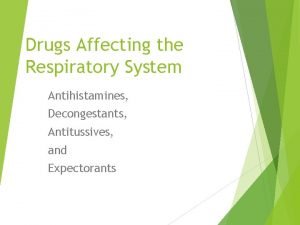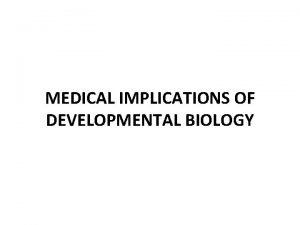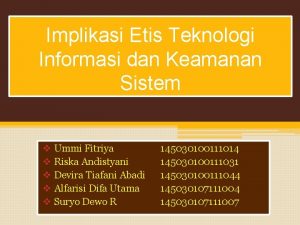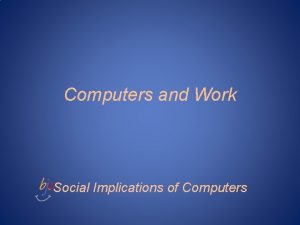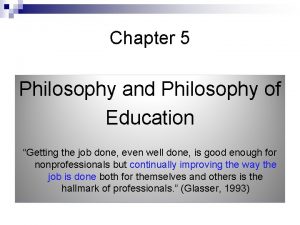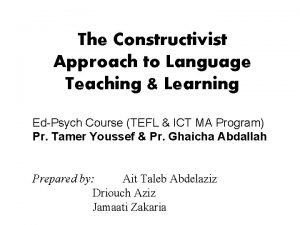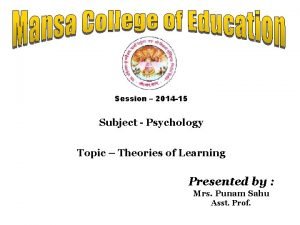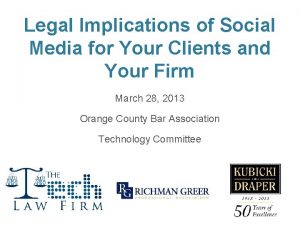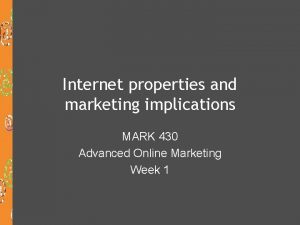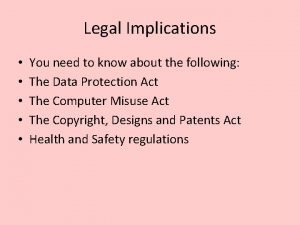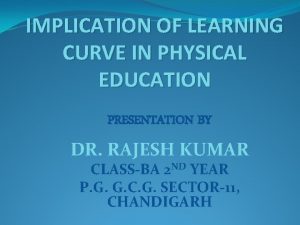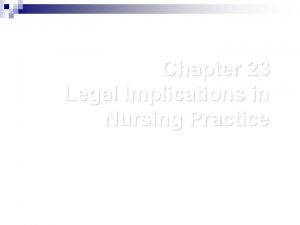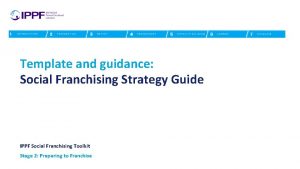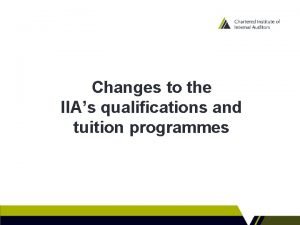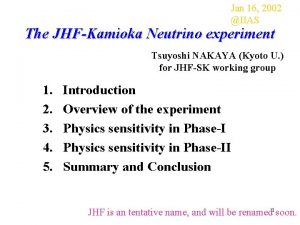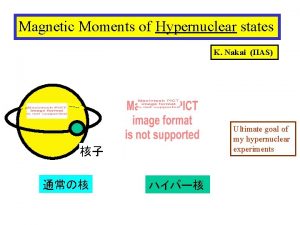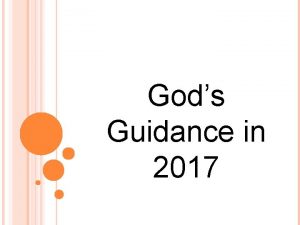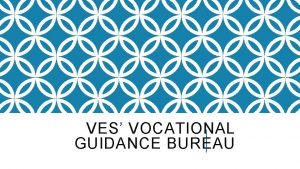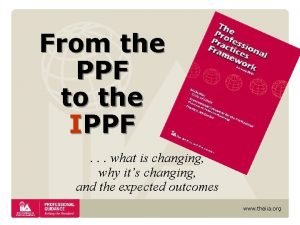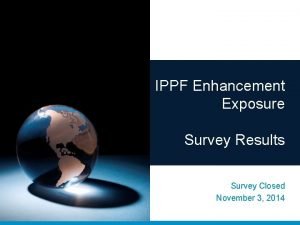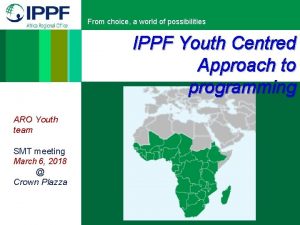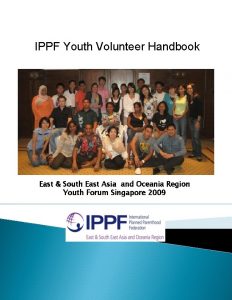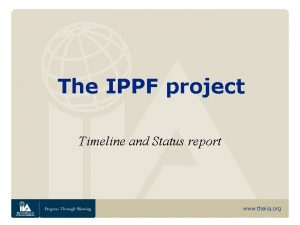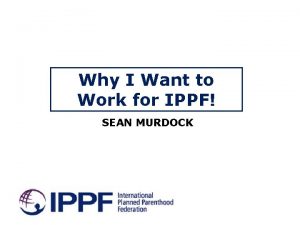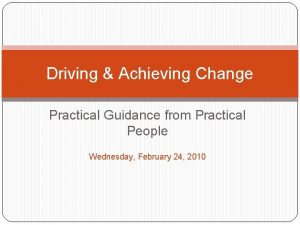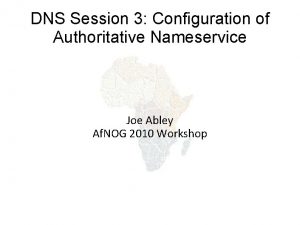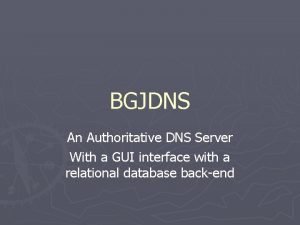The IIAs Authoritative Guidance Practical Implications The IPPF


































- Slides: 34

The IIA’s Authoritative Guidance Practical Implications The IPPF & the professional practice of internal auditing www. theiia. org

Scope & Structural Changes PPF Organizes all IIA guidance ELEMENTS REMOVED IPPF Organizes The IIA’s authoritative guidance ELEMENTS Definition Code of Ethics International Standards Practice Advisories Development and Practice Aids Position Papers ADDED Practice Guides www. theiia/guidance/ippf. org 2

Contextual Changes PPF ELEMENTS IPPF No change Definition Code of Ethics REMOVED ELEMENTS No change Code of Ethics International Standards Some changes International Standards Practice Advisories Some changes Practice Advisories Development and Practice Aids Position Papers ADDED Practice Guides www. theiia/guidance/ippf. org 3

IPPF The International Professional Practices Framework organizes The IIA’s authoritative guidance AUTHORITATIVE GUIDANCE Mandatory Non mandatory Strongly recommended www. theiia/guidance/ippf. org 4

Elements IPPF Definition Statement of fundamental purpose, nature, and scope of internal auditing. Code of Ethics Statement of principles and expectations governing behavior of individuals and organizations in the conduct of internal auditing. Description of minimum requirements for conduct. Describes behavioral expectations rather than specific activities. International Standards Mandatory requirements consisting of: • Statements of basic requirements for professional practice of internal auditing and for evaluating the effectiveness of its performance, which are internationally applicable at organizational and individual levels. Principle-focused and provide a framework for performing and promoting internal auditing. Includes Attribute, Performance and Implementation Standards. • Interpretations, which clarify terms or concepts within the Statements. Consider both Statements and Interpretations to understand apply correctly. Position Papers IIA statement to assist a wide range of interested parties, including those not in internal auditing profession, in understanding significant governance, risk or control issues and delineating related roles and responsibilities of internal auditing. Practice Advisories Address approach, methodology and considerations, but NOT detailed processes and procedures. Concise and timely guidance to assist internal auditors in applying Code of Ethics and Standards and promoting good practices. Includes practices relating to: international, country, or industry specific issues; specific types of engagements; and legal or regulatory issues. Practice Guides Detailed guidance for conducting internal audit activities. Includes detailed processes and procedures, such as tools and techniques, programs, and step-by-step approaches, including examples of deliverables. www. theiia/guidance/ippf. org 5

Definition of Internal Auditing No Change • Internal auditing is an independent, objective assurance and consulting activity designed to add value and improve an organization's operations. It helps an organization accomplish its objectives by bringing a systematic, disciplined approach to evaluate and improve the effectiveness of risk management, control, and governance processes. www. theiia/guidance/ippf. org 6

Code of Ethics No Change • Integrity – The integrity of internal auditors establishes trust and thus provides the basis for reliance on their judgment. • Objectivity – Internal auditors exhibit the highest level of professional objectivity in gathering, evaluating, and communicating information about the activity or process being examined. Internal auditors make a balanced assessment of all the relevant circumstances and are not unduly influenced by their own interests or by others in forming judgments. • Confidentiality – Internal auditors respect the value and ownership of information they receive and do not disclose information without appropriate authority unless there is a legal or professional obligation to do so. • Competency – Internal auditors apply the knowledge, skills, and experience needed in the performance of internal auditing services. www. theiia/guidance/ippf. org 7

Standards Some Changes • Semantic/Glossary • New Standards • Modifications • Interpretations www. theiia/guidance/ippf. org 8

Standards Semantic New Standards Modifications Interpretations Terminology • Previously, the word should was used throughout the Standards. • The use of the word should represented a mandatory obligation. www. theiia/guidance/ippf. org 9

Standards Semantic New Standards Modifications Interpretations The use of should has been replaced by must, with the exception of these five Standards: • Standard 1010 • Standard 2050 • Standard 2130. A 2; 2130. A 3 • Standard 2220. A 2 www. theiia/guidance/ippf. org 10

Standards Semantic New Standards Modifications Interpretations New terms added to the glossary • • • Information technology control Information technology governance Technology-based audit techniques Risk appetite Significance www. theiia/guidance/ippf. org 11

Six New Standards Semantic New Standards Modifications Interpretations ATTRIBUTE STANDARDS • 1010 – Recognition of the Definition of Internal Auditing, the Code of Ethics and the Standards in the internal audit charter • 1111 – Direct interaction with the board of directors PERFORMANCE STANDARDS • 2110. A 2 – Assessing information technology governance • 2120. A 2 – Evaluation of the risk of fraud • 2120. C 3 – Limitation of the internal auditors’ role with the risk management scope • 2430 – Use of “conducted in conformance with the International Standards for the Professional Practice of Internal Auditing” www. theiia/guidance/ippf. org 12

Standards Semantic New Standards Modifications Interpretations Other modifications • Improved some Standards by enhancing understanding, while preserving the original meaning. For example, the 1300 series has been reworded for enhanced clarity. • Made numbering changes to the 2110, 2120, and 2130 series to reflect better logic of the relationships among the topics: – 2110: Governance (previously, 2130) – 2120: Risk (previously, 2110) – 2130: Control (previously, 2120) www. theiia/guidance/ippf. org 13

Standards Semantic New Standards Modifications Interpretations to clarify concepts within a particular statement have been added to the mandatory guidance. – Nine for Attribute Standards – Ten for Performance Standards www. theiia/guidance/ippf. org 14

Interpretation Example: 1320 – Reporting on the Quality Assurance and Improvement Program The chief audit executive must communicate the results of the Quality Assurance and Improvement Program to senior management and the board. Interpretation: The form, content, and frequency of communicating the results of the quality assurance and improvement program is established through discussions with senior management and the board and considers the responsibilities of the internal audit activity and chief audit executive as contained in the internal audit charter. To demonstrate conformance with the Definition of Internal Auditing, the Code of Ethics, and the Standards, the results of external and periodic internal assessments are communicated upon completion of such assessments and the results of ongoing monitoring are communicated at least annually. The results include the reviewer’s or review team’s assessment with respect to the degree of conformance. www. theiia/guidance/ippf. org 15

Practice Advisories (PAs) • Significant clean-up, leading to a reduction of the number of Practice Advisories from 83 to 42. • Practices Advisories have been re-written to achieve: – Conciseness. – Describe a method, an approach or consideration to assist internal auditors in applying a specific Standard or requirement of the Code of Ethics. www. theiia/guidance/ippf. org 16

New Practice Advisories Example www. theiia/guidance/ippf. org 17

PAs related to Attribute Standards 1000 -1: Internal Audit Charter 1110 -1: Organizational Independence 1111 -1: Board Interaction 1120 -1: Individual Objectivity 1130 -1: Impairments to Independence or Objectivity 1130. A 1 -1: Assessing Operations for Which Internal Auditors were Previously Responsible 1130. A 2 -1: Internal Audit’s Responsibility for Other (Non-audit) Functions 1200 -1: Proficiency and Due Professional Care 1210 -1: Proficiency 1210. A 1 -1: Obtaining Services to Support or Complement the Internal Audit Activity 1220 -1: Due Professional Care 1230 -1: Continuing Professional Development 1300 -1: Quality Assurance and Improvement Program 1310 -1: Requirements of the Quality Assurance and Improvement Program 1311 -1: Internal Assessments 1312 -1: External Assessments 1312 -2: External Assessment - Self Assessment with Independent Validation 1321 -1: Use of “Conforms with the International Standards for the Professional Practice of Internal Auditing” www. theiia/guidance/ippf. org 18

PAs related to Performance Standards 2010 -1: Linking the Audit Plan to Risk and Exposures 2210. A 1 -1: Risk Assessment in Engagement Planning 2020 -1: Communication and Approval 2230 -1: Engagement Resource Allocation 2030 -1: Resource Management 2240 -1: Engagement Work Program 2040 -1: Policies and Procedures 2330 -1: Documenting Information 2050 -1: Coordination 2330. A 1 -1: Control of Engagement Records 2060 -1: Reporting to Senior Management and the Board 2330. A 2 -1: Retention of Records 2120 -1: Assessing the Adequacy of Risk Management Processes 2340 -1: Engagement Supervision 2130 -1: Assessing the Adequacy of Control Processes 2130. A 1 -1: Information Reliability and Integrity 2130. A 1 -2: Evaluating An Organization's Privacy Framework 2410 -1: Communication Criteria 2420 -1 Quality of Communications 2440 -1: Disseminating Results 2500 -1: Monitoring Progress 2200 -1: Engagement Planning 2210 -1: Engagement Objectives 2500. A 1 -1: Follow-up Process www. theiia/guidance/ippf. org 19

Position Papers • Two Position Papers have been added to the IPPF: – The Role of Internal Auditing in Enterprise Risk Management – The Role on Internal Auditing in Resourcing the Internal Audit Activity www. theiia/guidance/ippf. org 20

Practice Guides • 11 Global Technology Audit Guides (GTAG) • Guide on the assessment of IT Risk (GAIT) • Additional Practice Guides will be issued regularly www. theiia/guidance/ippf. org 21

GTAG-1 Information Technology Controls • Understanding IT controls • Importance of IT controls • Organizational roles and responsibilities for ensuring IT controls • Analyzing risks • Monitoring techniques • IT control assessment www. theiia/guidance/ippf. org 22

GTAG-2 Change and Patch Management Controls: Critical for Organizational Success • Why IT change and patch management controls are foundational to a healthy IT environment • How IT change and patch management controls help manage IT risks and costs • What works and doesn’t work in practice • Sources of change and the likely impact on business objectives www. theiia/guidance/ippf. org 23

GTAG -3 Continuous Auditing: Implications for Assurance, Monitoring, and Risk Assessment • Role of continuous auditing in today’s internal audit environment • Relationships among continuous auditing, continuous monitoring, and continuous assurance • The application and implementation of continuous auditing • Benefits of a continuous, integrated approach www. theiia/guidance/ippf. org 24

GTAG-4 Management of IT Auditing • Defining IT • IT-related Risks • Defining IT Audit Universe • Executing IT Auditing • Managing IT Auditing • Emerging Issues www. theiia/guidance/ippf. org 25

GTAG-5 Managing and Auditing Privacy Risks • What is Privacy • Privacy Principles and Frameworks • Privacy Impacts and Risk Model • Privacy Controls • Good and Bad Performers • Internal Auditing's Role • Auditing Privacy • CAE's Top 10 Privacy Questions www. theiia/guidance/ippf. org 26

GTAG-6 Managing and Auditing IT Vulnerabilities • Defining the vulnerability management lifecycle • The scope of a vulnerability management audit • Organizational maturity • Metrics to measure vulnerability management practices • Top 10 vulnerability management questions www. theiia/guidance/ippf. org 27

GTAG-7 Information Technology Outsourcing • Choosing the right IT vendor • What are the best ways to manage outsourcing contract agreements? • What are the main outsourcing risks and how can you mitigate them? • Key outsourcing control considerations from the standing points of both client operations and service provider operations • Which is the most effective framework for establishing outsourcing controls? www. theiia/guidance/ippf. org 28

GTAG -8 Auditing Application Controls • What is application control and what is the relationship between application control and general controls? • Why rely on application controls? • How do you scope a risk-based application control review? • What are the steps to conduct an application controls review? • A list of key application controls and a sample audit program www. theiia/guidance/ippf. org 29

GTAG-9 Identity and Access Management – The process of managing who has access to what information – Not only IT, but a cross-organizational process – Internal auditor has a role. • Key IAM concepts • Risks associated with IAM process • Detail guidance on how to audit the IAM process • A sample checklist for auditors www. theiia/guidance/ippf. org 30

GTAG-10 Business Continuity Management Restoring critical business processes after a disaster • Management support • Risk assessment • Business Impact analysis • Business recovery and continuity strategy • Disaster recovery for IT • Awareness, training, and testing • BCM program maintenance • Crisis communication www. theiia/guidance/ippf. org 31

GTAG-11 Developing the IT Audit Plan The audit plan is the weakest link… • Understanding the organization and how IT supports it • Defining and understanding the IT environment • Using risk assessment to determine the IT audit universe • Formalizing the annual IT audit plan • Executing the steps necessary for developing the IT audit plan www. theiia/guidance/ippf. org 32

Guide to the Assessment of IT Risk (GAIT) • GAIT Methodology – top-down risk-based scoping methodology • GAIT for IT General Control Deficiency Assessment - help assess IT general controls deficiencies identified • GAIT for Business and IT Risk – help identify critical aspects of IT processes www. theiia/guidance/ippf. org 33

Practice Guides In the pipeline: • Fraud Detection in an Automated World (2009) • Auditing IT Projects (2009) • Security Management: Audit Security Governance (2009) • Entity Level IT Controls (2010) • Auditing User Developed Applications (2010) www. theiia/guidance/ippf. org 34
 Ippf standards
Ippf standards Iias
Iias Iias
Iias Authoritative teacher
Authoritative teacher Most authoritative dictionary
Most authoritative dictionary Salman ahmad awan
Salman ahmad awan Exploitative authoritative example
Exploitative authoritative example Benevolent authoritative system
Benevolent authoritative system Authoritative sources in a hyperlinked environment
Authoritative sources in a hyperlinked environment Anti monson curve
Anti monson curve Direct vs indirect guidance
Direct vs indirect guidance Father of personal identification?
Father of personal identification? Future implications definition
Future implications definition Nursing implications for synthroid
Nursing implications for synthroid Vygotsky guided participation example
Vygotsky guided participation example Language
Language Example of proposition in math
Example of proposition in math Trends and issues in nursing
Trends and issues in nursing Novolog nursing implications
Novolog nursing implications Characteristics of database approach
Characteristics of database approach Social learning theory bandura 1971
Social learning theory bandura 1971 How audience negotiate meaning in mil
How audience negotiate meaning in mil Benzonatate nursing implications
Benzonatate nursing implications Medical implications of developmental biology
Medical implications of developmental biology Implikasi etis adalah
Implikasi etis adalah Social implications of computers
Social implications of computers Philosphy theories
Philosphy theories Chronotropic
Chronotropic Social constructivist meaning
Social constructivist meaning S-r bond theory
S-r bond theory Legal implications of social media
Legal implications of social media Marketing implications
Marketing implications What are legal implications
What are legal implications Learning curve in physical education
Learning curve in physical education Chapter 23 legal implications in nursing practice
Chapter 23 legal implications in nursing practice
